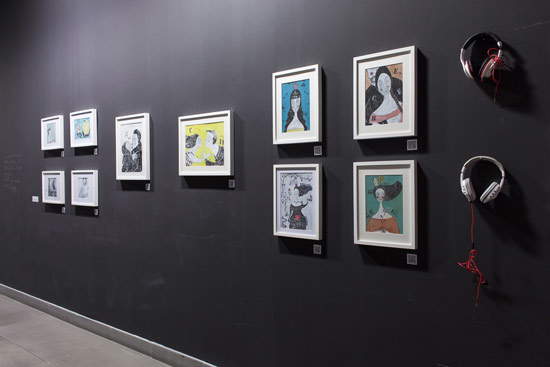by Federico Giannini (Instagram: @federicogiannini1), published on 26/05/2016
Categories: Works and artists
/ Disclaimer
How does art look at liquid society? Thirteen young artists question themselves in an exhibition at CAMeC (La Spezia).
Those who, until June 5, would like to enter the CAMeC in La Spezia (a city from whose toponym, as an inhabitant of the area, I carefully omit the article) to see how a group of thirteen contemporary artists questions the concept of community in today’s society, it won’t hurt to brush up on Umberto Eco to read an article of his from last year, moreover included in the usual posthumous collection published within hours of his passing (to be exact, just three days after his funeral), which might provide some cues (whether positively or negatively depends on the reader’s sensibilities and visions) to approach the exhibition #community! Community through the gaze of contemporary artists, curated by Cinzia Compalati and Andrea Zanetti. In his article, Eco quotes Zygmunt Bauman, theorist of liquid society, to try to give an edible definition of the latter that is suitable even for an audience not accustomed to sociology treatises. Says Eco: “For Bauman, among the characteristics of this present,” that is, the time in which we live, the time of the “liquid society,” “can be counted the crisis of the state.” “Supernational entities,” after all, have limited the decision-making power of nation-states, Eco continues. So “there disappears an entity that guaranteed individuals the possibility of homogeneous solutions to the various problems of our time, and with its crisis here came the crisis of ideologies, and therefore of parties, and in general of any appeal to a community of values that allowed the individual to feel part of something that interpreted his or her needs. With the crisis of the concept of community emerges an unbridled individualism, where no one is any longer each person’s companion but antagonist, to be guarded against.” An individualism that would “undermine the foundations of modernity”: reference points would disappear and “everything would dissolve into a kind of liquidity.”
Certainties would be missing, in short: liquid society is based on constantly changing structures. Of course: echoing Esterházy, one might think that in reality there never existed a time when there were absolute certainties, and that history has only ever known “epochs of transition.” The phenomenon of liquidity, however, would be new to Bauman: we find ourselves, according to the Polish sociologist, in an era in which the whole system of values on which our society and our sense of belonging have been based (traditions, stable ties, rules) has been gradually shattered. “I use the word ’liquid,’” Bauman wrote, “because liquid modernity cannot stand and keep the same shape for long.” And if certainties are lacking, social relations, according to this view, can only falter. Starting with what is regarded as the fundamental core of society, the family, because insecurity also causes emotional relationships to become liquid, fragile, delicate. Bauman talked about these issues in Liquid love, a book released in Italy under the title “Liquid Love.” At CAMeC, the fragility of emotional ties is skillfully described by Stefano Lanzardo in his installation Sunday Morning. Four figures, who appear to us as if enveloped in a fog that conceals the traits that should characterize them individually, remain each absorbed in their own thoughts. There is a father, a mother and a child who do not look at each other: too self-absorbed to avoid caring about each other, with the father being completely absorbed in the tablet he holds in his hand, the mother striding around looking around, probably to check if anyone notices her flashy clothing, and the child lonely frolicking with a skateboard. All under the questioning gaze of a little girl who seems to have discerned, in these three characters, the characteristics of that individualism of which Eco speaks. For which, however, it would be more appropriate to use a different adjective: “deterrent” is perhaps a term that fits better. For this is not an individualism in the highest philosophical sense of the term: there is no one who aims to free himself from an oppressive bondage with the aim of obtaining a freedom that he can dispose of independently, there is no one who attempts to protect himself, even in association with his neighbor, from the domination that society exercises over him. On the contrary, it is an illusory individualism, based on consumerism, which aims at the fulfillment of ephemeral desires of the lowest stature, and which has simply replaced the ancient gods with unseen deities, with the result that the individual still continues to be a slave and a succubus. And this aspect is well highlighted by Zino’s Holy writs: hung on the wall, the Bible and the Koran lose consistency until they crumble into tiny colored pixels, and above a kneeler, of the kind that can be found in any church, the sacred text has been replaced by an Ikea catalog.
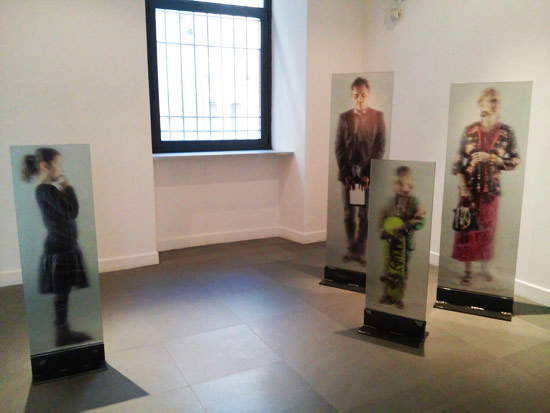 |
| Stefano Lanzardo, Sunday Morning (2015) |
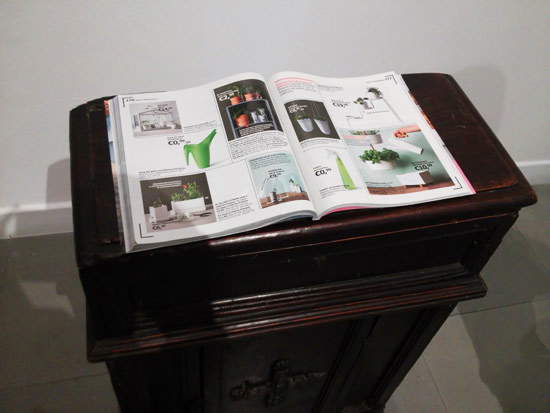 |
| Zino, Holy Writs (2016, detail) |
On the other hand, this enslavement is well exemplified by Entrelazos by Lorena Huertas, one of the strongest personalities in the #community group (and she could only come up with one of the most interesting works in the entire exhibition). A door is held down by a series of threads, as red as blood, that prevent it from being opened: the problem is that, even should a particularly willing and courageous soul want to unravel the intricate ball of yarn, beyond the door he would find nothing but the wall. A work rich in philosophical suggestions, it can be read in many different ways. One can easily range from Hobbes to Nietzsche via Spinoza, Stirner, Marx, until, of course, Bauman, who has written many pages on the relationship between freedom and security, which he considers “without a shadow of a doubt the two central values of human life,” and at the basis of a balance that is often fragile and in any case extremely difficult to reconcile: “in the continual search for a satisfactory balance between freedom and security it seems that we follow the movement of a pendulum rather than the trajectory of an arrow.” This is perhaps the main dilemma of liquid society. And again, “the more freedom we have, the heavier and more threatening it seems to us.” Freedom, after all, comes with burdens: the thread of Lorena Huertas thus leads (backwards, physically following the path of the exhibition) to the Aggregations of Carolina Barbieri, the youngest artist in #community, born in 1991 and therefore fully “inserted” in liquid society, along with many of her (and our) young peers. And within this society, young people for Carolina Barbieri move as if they were tied to invisible threads inside a prison that has no bars. Same faces, same movements, and again the absence of individual traits. We are, in short, still on this side of Lorena Huertas’ door, and we move through a freedom that is perhaps apparent, or perhaps conscious, but of which one does not want to face the heavy burden.
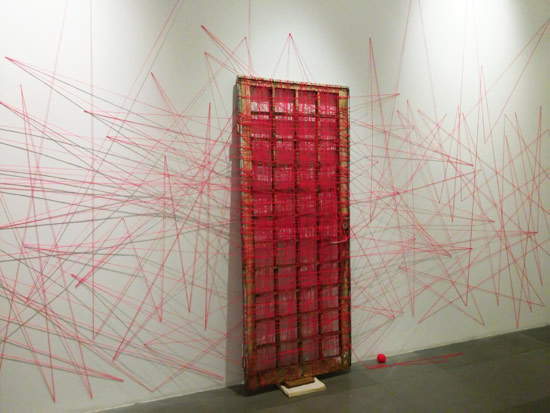 |
| Lorena Huertas, Entrelazos (2015) |
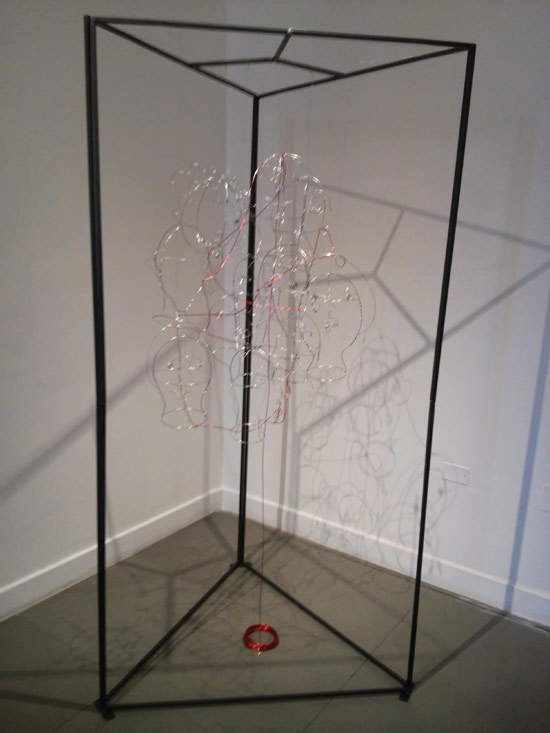 |
| Carolina Barbieri, Aggregations (Mirage) (2016) |
If there is one thing that is striking about the entire journey of #community, it is the prevalence of a pessimistic, or at least nostalgic viewpoint for a past that, perhaps, never even existed (but we should not be surprised: this is the attitude that prevails even outside the walls of CAMeC, in everyday life). Therefore, the tender and human emotions of Enrica Pizzicori’s Fa volare cannot be read positively either: it is rhetoric of remembrance gathered in a more than private dimension, in which the very concept of community appears as reduced to the bone and seems to fall back on a few, intimate certainties. The only space for a different gaze, one that looks at today’s society perhaps with a certain confidence (perhaps unconscious, but nonetheless surfacing) is offered by Roberta Montaruli’s If I Were Taller #2: the pessimism that results in an urban environment devoid of human presences is partly offset by the hope that, as the accompanying tag reads, “if we were all taller we would see different worlds.” Liquidity may have undermined certainties (assuming, in the past, there were any) but it has opened up for pluralistic vision and confrontation, the gods of the past have been replaced by equally disturbing deities but these are not necessarily definitive, and there is still the possibility of casting a further glance to see those “different worlds” Roberta Montaruli’s work hints at. A liquid something is, by its very nature, opposed to something that is in danger of stiffening. On the finale of the article quoted in the opening, Eco, joining the large group of pessimists, believed that it was necessary to “survive liquidity,” that such survival required “new tools” (which ones, however, it is not known), and that the trouble was that “politics and to a large extent the intelligentsia have not yet grasped the extent of the phenomenon.” But if for some time now (as Guido Crainz also recalled in Repubblica a few years ago, and the situation has certainly not changed since then) politics and, I would add, the self-styled “intelligentsia” have been aiming atself-preservation, what is the point of asking whether they possess the tools to enable us to live as well as possible in today’s world? The only conclusion is that transformations can only come through us and our gazes, which should push higher to “see different worlds.” And in this sense, the perspectives offered by #community, an exhibition full of interesting suggestions, are particularly inspiring.
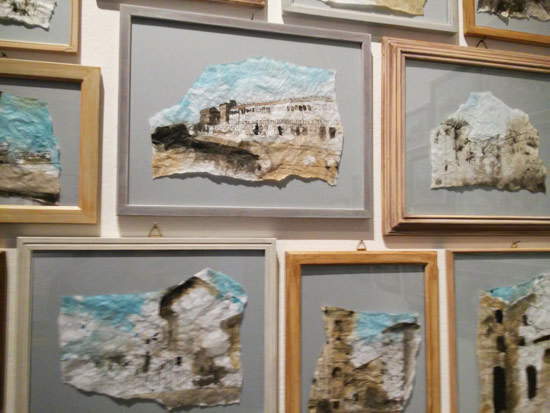 |
| Roberta Montaruli, If I were taller #2 (2016, detail) |
Warning: the translation into English of the original Italian article was created using automatic tools.
We undertake to review all articles, but we do not guarantee the total absence of inaccuracies in the translation due to the program. You can
find the original by clicking on the ITA button. If you find any mistake,please contact us.




